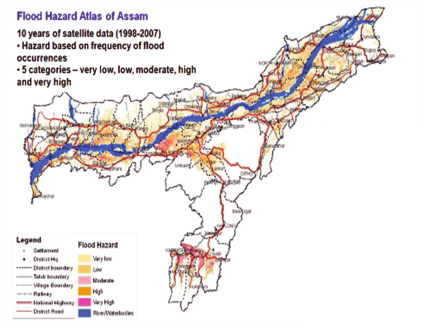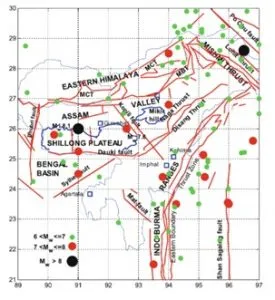Syllabus: GS-III & V: Disaster Management
Why is this in the news?
Assam features regularly in news cycles because of recurring monsoon floods, river-bank erosion and increasing urban flooding, together with periodic landslides and earthquake risk. Recent years have seen large-scale displacements and repeated warnings from state agencies about embankment breaches, groundwater stress in Guwahati, and the need for landscape-scale solutions. Recent government reviews and budget allocations underline why Assam’s disaster preparedness and mitigation remain topical.
About disaster risk in Assam
- Geography & monsoon: Assam lies in the Brahmaputra valley with a large floodplain, receives heavy monsoon precipitation and river inflows from Himalayan tributaries.
- Floods & erosion: Annual monsoon floods are endemic; in extreme years millions are affected and large areas of cropland and settlements are inundated.
- For example, the 2020 and 2022 flood episodes affected millions of people and thousands of villages.
- Seismic hazard: A significant portion of Assam lies in very high seismic hazard zones.
- Assam witnessed 1897 & 1950 earthquakes (8.7 magnitude) with fewer casualties then due to sparse settlement.
- Droughts: Drought episodes in Assam are worsening due to climate change/global warming.
- Crop failure, water scarcity, and falling groundwater levels in Guwahati due to deep boring by builders.
- Other hazards: Landslides in hill margins, urban flooding in Guwahati and local industrial/chemical accidents add to the multi-hazard profile.


Reasons for the recent rise in disaster risk
- Changing climate: Increased intensity and unpredictability of rainfall events, longer dry spells and temperature variability have amplified flood and drought extremes.
- Hydro-geomorphic dynamics: Riverbank erosion, sediment deposition and channel migration increase displacement and infrastructure loss; embankment breaches are recurrent.
- Land-use change & wetlands loss: Conversion of floodplains and wetlands to agriculture, settlements and urban areas reduces natural buffering capacity.
- The survey identifying 271 wetlands suitable for floodwater diversion highlights this problem.
- Unplanned urbanisation: Rapid and often unregulated construction in Guwahati (hill-cutting, high-rise projects, encroachment of low-lying areas), poor stormwater drainage and groundwater over-extraction increase urban flood risk and water stress.
- Infrastructure & governance gaps: Old/poorly maintained embankments, weak land-use enforcement, and occasional collusion between builders and local bodies reduce resilience.
- High exposure: Growing population density in floodplains and city cores means more people and assets are exposed — historical earthquakes that were less deadly due to sparse settlement would now have far worse consequences.
Assam’s disaster preparedness
Institutional architecture
- National to district: NDMA (apex — PM as chair), NDRF (response force), SDMA (State Disaster Management Authorities), and DDMA (District Disaster Management Authorities) form the multi-tier system envisaged in the 2005 Act. The State’s ASDMA is the nodal body for Assam.
State mechanisms & tools
- ASDMA & plans: Assam State Disaster Management Plan (SDMP), manuals, audits, school safety policy and annual reports provide frameworks for preparedness.
- Early warning & forecasting: Flood forecasting stations and real-time monitoring on the Brahmaputra and tributaries, coupled with state web portals and GIS mapping, enable pre-emptive alerts and planned evacuations.
- Capacity building & engagement: Training programmes for officials, volunteers, and responders; mock drills and school safety programmes strengthen preparedness.
- Response finances: Assam utilises the State Disaster Response Fund (SDRF) for immediate relief and can seek NDRF assistance when damage exceeds SDRF capacity.
About ASDMA
- Chair & structure: ASDMA is chaired by the Chief Minister and includes senior ministers and officials for inter-departmental coordination.
- The State Executive Committee (SEC) chaired by the Chief Secretary executes policies and coordinates response.
- Functions: Policy formulation, planning (state and district DMPs), capacity building, awareness campaigns, early warning coordination, post-disaster needs assessment, and management of SDRF/NDRF resources.
Enactment of the Disaster Management Act, 2005
- Paradigm shift: The Act mandated a forward-looking framework prioritising prevention, mitigation and preparedness alongside response. It created NDMA, SDMAs and DDMAs and gave legal backing to integrated planning and evacuation.
- Assam timeline: The State adopted the Act on 19 August 2006 and set up ASDMA in 2009. District DDMAs were also notified.
- This institutionalised disaster risk management beyond ad-hoc relief.
Objectives of disaster management in Assam
- Promote a culture of prevention, preparedness and resilience through knowledge, innovation and education.
- Encourage mitigation strategies combining technology, traditional wisdom and environmental sustainability.
- Mainstream disaster management into development planning at all levels.
- Empower communities to lead local preparedness through self-reliance and decision-making.
Shifting from reactive to proactive approach
- From Relief to Risk Reduction: The earlier Relief Manual has been supplemented by SDMPs, statutory rules and preparedness measures.
- Early warning to evacuation: Flood forecasting and community alert systems have enabled pre-emptive evacuations, reducing mortality.
- Technology & planning: Use of GIS, satellite imagery, web portals and wetland rehabilitation projects indicate a science-based shift in mitigation.
Recent developments and future outlook
Recent developments
- Wetland restoration: Identification of 271 wetlands for floodwater diversion to supplement embankments.
- Urban flooding focus: Partnerships with technical institutes like IIT Roorkee for Guwahati flood management.
- Embankment & erosion control: Greater emphasis on strengthening embankments and tackling erosion.
- Displacement & humanitarian concerns: Floods in 2020 and 2022 displaced millions, testing relief systems.
Future outlook
- Integrated flood management combining embankments, wetlands and zoning.
- Climate adaptation strategies mainstreamed into agriculture, water and urban planning.
- Strengthening DDMAs, Panchayats and community first responders.
- Sustainable urban governance with strict building codes and stormwater management.
- Forecast-based financing and anticipatory action to move resources before disasters strike.
Way forward
- Landscape solutions: Wetland rejuvenation and floodplain restoration.
- Integrated river basin management: Coordination with upstream states for sediment and flow regulation.
- Urban resilience: Enforce building codes, prevent hill-cutting, upgrade drainage.
- Community empowerment: Train local committees, institutionalise contingency plans.
- Forecast-based financing: Use forecasts for cash transfers and pre-emptive relief.
- Data & research partnerships: Scale up collaboration with NESAC, IITs, and universities.
- Groundwater sustainability: Regulate borewell extraction in Guwahati; expand piped water supply.
- Finance & insurance: Strengthen SDRF/NDRF usage; expand crop and property insurance.
Conclusion
Assam’s hazard profile — floods, seismicity, erosion, urban flooding and drought — demands a whole-of-society, multi-modal response. The Disaster Management Act (2005) and ASDMA provide the legal and institutional framework; recent initiatives (wetland restoration, technology collaborations, improved early warning) indicate a shift from relief to resilience. Success, however, depends on implementing landscape-based solutions, enforcing urban regulations, strengthening local capacities and aligning finance to anticipatory action.
Mains Questions
- “Assam’s recurring floods and increasing urban water-stress are the product of both natural processes and human actions.” Analyse the causes, evaluate the state’s preparedness and suggest measures to reduce disaster risks. (250 words/15 marks)
- “The Disaster Management Act, 2005 transformed India’s response to disasters.” Discuss how the Act’s institutional architecture has translated into resilience at the state level — with special reference to Assam. (150 words/10 marks)
Start Yours at Ajmal IAS – with Mentorship StrategyDisciplineClarityResults that Drives Success
Your dream deserves this moment — begin it here.



